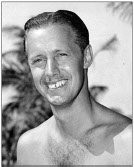
Colonel Frank Kurtz (USA)
Honor Pioneer Diver (2012)
FOR THE RECORD: 1932 OLYMPIC GAMES: bronze (lOm platform); 1936 OLYMPIC GAMES: 5th place; 1940 OLYMPIC GAMES: cancelled; ONE U.S. NATIONAL CHAMPIONSHIP: lOm platform (1933); FIRST U.S. DIVER TO QUALIFY FOR THREE OLYMPIC TEAMS.
Frank Kurtz grew up in Kansas City, Missouri, a decidedly independent child who began making legends early. Tired of his step-father’s beatings, he ran away from home when he was 12. Like a lot of runaways in the 1920’s, he found a job hawking newspapers. And in a pattern that would repeat itself throughout his life, his charm, winning personality, and sense of adventure soon brought him the attention of wealthy patrons at the Kansas City Athletic Club (KCAC).
It was in the pool that he discovered diving. He met Johnny Weissmuller and when he asked the future Tarzan how he could be an Olympic diver, Johnny told him to find a skilled coach like Clyde Swenson, of the Hollywood Athletic Club (HAC) in California. Taking the advice to heart, Frank hitchhiked to Los Angles, found Swenson and impressed him so much that Swenson took him in and virtually adopted Frank. He soon became a favorite among the members of the HAC just like at the KCAC.
When he was sixteen, the Orange soda magnate Frank Birely taught him to fly and by the time he graduated from Hollywood High in 1931, he held three junior world flying records including the speed record for flying 152 miles per hour. A few weeks after setting this flying speed record, Frank was told the club couldn’t afford to take him to the A.A.U. National Diving Championship meet in Hawaii. Knowing he would need to make a name for himself at a major meet if he was going to make the Olympic team the next year, he secured passage by signing on as a seaman on a tanker and arrived in Honolulu just in time to enter the meet. He placed second, scoring enough points for the Hollywood club to win the title. After the meet, he disappeared, only to later turn up as a stowaway on the steamer” Malolo”for his passage back. He was now on his way to making the Olympic team.
In an era of American diving dominance, Frank Kurtz was the first diver to qualify for three Olympic teams. In 1932, he won the bronze medal off the !Om platfo,m. Watching the tryouts for the U.S. Olympic team in 1936, the legendary sports writer Grantland Rice rated Kurtz the greatest exhibition diver in the world. However, on the ship to Germany, Frank injured his shoulder so badly that the coaches tried to keep him from diving. He dove anyway and finished fifth. The next year he had an offer fom Billy Rose to star in the Aquacade, but before he signed the contract, he received word he had been accepted into the Army Air Corps. So he joined the Army and won more national flying titles.
With the outbreak of World War II and his third Olympic Games canceled, Kurtz was sent to Clark Field in the Philippines. Colonel Kurtz’s wartime exploits were recounted in two contemporary best sellers, Queens Die Proudly and My Rival The Sky, a memoir written by Frank’s wife Margo. He was the most decorated bomber pilot of World War II, and his plane dubbed the “Swooze”, can be seen today at the National Air Force Museum in Dayton, Ohio. It’s also where he derived the name for his daughter, the actress Swoozie Kurtz.
Kurtz stayed active in the diving community after the war, serving as an Olympic judge. He was part of Peter Ueberroth’s 01 ympic organizational team for the 1984 Olympic Games. One of his assignments was to hang an honorary Olympic gold medal around the neck of President Reagan.
Kurtz passed away in 1996 at the age of 85.
